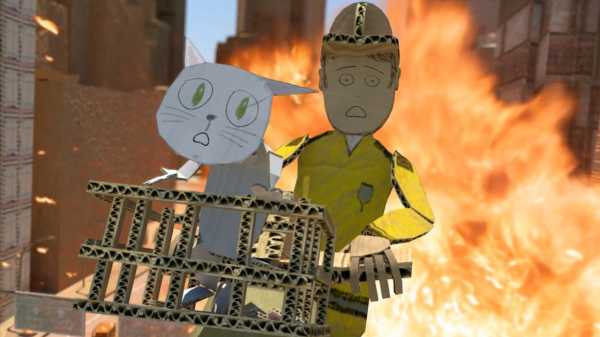
The clever and freewheeling nine-minute animated short “Fire in Cardboard City,” directed by Phil Brough, which had its U.S. début at this year’s Tribeca Film Festival, is a mini disaster movie that feels like a joyride. It begins with sirens, action music, and a cardboard car careening across a cardboard bridge, chased by cardboard cops through an elaborate cardboard metropolis. The fleeing driver’s agitated expression appears to have been drawn on in ballpoint pen. The 3-D animation is extremely realistic, as if an ambitious child created a miniature world, à la Caine’s Arcade, and it suddenly came to life. Some details evoke action-movie imagery—a honking, swerving semi, a car flipping onto its hood—and others are distinctly original, such as a crudely crayonned sign above a store that says “Cardigans & Jerseys.” As the car skids on its roof, sparks pop and a realistic-looking fire breaks out; the scene cuts to a cardboard fire station, where the alarm rings and the cardboard firefighters start screaming. We watch the ensuing chaos and heroism with a pang of anxiety for this homespun cardboard world.
Brough, who is forty-six, is a New Zealander, and an animator with a comedy background; he was on a late-aughts New Zealand comedy series, “Back of the Y,” whose co-creator, Matt Heath, co-wrote “Fire in Cardboard City” with him. Brough first used the cardboard style in a segment he did for the “ ‘Star Wars’ Uncut” project, from 2009, in which filmmakers re-created shots from “Star Wars” in a variety of styles. His contribution is a riff on the famous opening scene: overhead, we see a slowly gliding Imperial Star Destroyer, corrugated. “I was, like, Hey, that looks kind of cool,” Brough said recently. Like the residents of Cardboard City, he speaks with a Kiwi accent. “And then from there I thought, You know, I could take this a bit further.” Why cardboard? “A bit of a do-it-yourself look,” he said. “There were certain things that I could make look more real than others in 3-D. That one worked.” Cardboard isn’t very reflective, he pointed out—“I got away with making the whole thing flat-shaded,” he said, which simplifies the process—“and it is not organic. Living organic things are much harder to render in 3-D realistically than something like cardboard.” Pixar’s early films faced a similar challenge: there’s a reason they’re about toys, cars, and things with exoskeletons.
The results look so realistic that they could almost be stop-motion. “I built a big virtual set, I guess, is how you could describe it,” he said. “The characters are like stop-motion marionettes in a way; they have joints to the arms and the knees and all of that, and controllers.” He then used a low-budget motion-capture process—a D.I.Y. version of Hollywood’s green screens and Ping-Pong-ball suits—using the XBox Kinect and special software. “It sees you doing the motions you want the character to do, and then you can transfer that to the animation so you can transfer that onto your characters,” he said. He considered having a giant robot attack Cardboard City, and then settled on fire: that looked kind of cool, too.
For his first short film, having observed that many shorts are “rather hard going,” “quite heavy,” and “generally just really depressing,” Brough decided to make the antithesis of that: a film that “just outright entertains” and leaves audiences feeling happy. “The whole thing was to try and make it fun,” he said. A fan of genre films and blockbusters such as “Die Hard” and “Aliens,” he packed “Fire in Cardboard City” full of popcorn-movie tropes, gently subverted or made comic by the presence of paper. “I’m really into slapstick—Chuck Jones and Road Runner and Zucker Brothers stuff, visceral humor,” he said. In a playful reference to “Save the Cat,” a popular screenwriting guidebook he finds “slightly annoying,” a firefighter saves a cat, and the cat ends up doing a kind of Evel Knievel stunt. The film juxtaposes realistic sound with sophisto-crude visuals, which confuses your expectations a bit; a burning-building rescue that goes awry, via passing helicopter, turns a cardboard woman to confetti, in a way that evokes—and rebukes—thoughts of the disturbing comic violence of Tarantino and others. Intentionally or not—not, Brough insists—its mayhem can also provoke dark real-world associations: climate change, vulnerability to powers beyond our control. We’re all living in Cardboard City nowadays, I thought grimly at one point. But Brough’s explicit aim is escapism—no allegory allowed.
Brough is currently developing a related series to air in New Zealand, and is now happily in the process of visiting more disaster on Cardboard City’s unsuspecting residents, in the form of additional “blockbuster-type scenarios.” “I’m actually getting to do the giant robot, which is really fun,” he said, cheerfully. “It’s sort of like Godzilla. Then there will be an earthquake and an alien invasion.”
Sourse: newyorker.com






